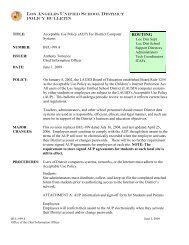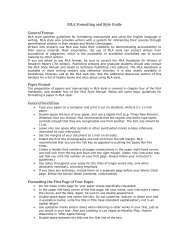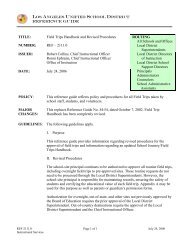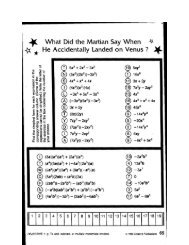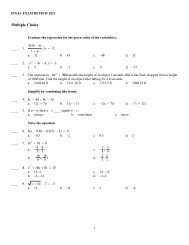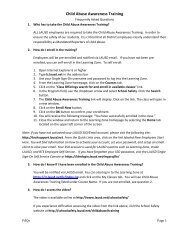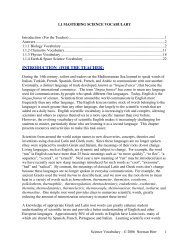Mr Galicia_s Syllabus Panorama Alg 1 - Panorama High School
Mr Galicia_s Syllabus Panorama Alg 1 - Panorama High School
Mr Galicia_s Syllabus Panorama Alg 1 - Panorama High School
Create successful ePaper yourself
Turn your PDF publications into a flip-book with our unique Google optimized e-Paper software.
<strong>Panorama</strong> <strong>High</strong> <strong>School</strong> (818) 9094500<br />
<strong>Alg</strong>ebra 1 <strong>Syllabus</strong><br />
<strong>Mr</strong>. <strong>Galicia</strong><br />
Room B204<br />
Course Description:<br />
Students will work further with irrational numbers. Students will learn to work with linear equations that include tables,<br />
graphs and data. Students will solve linear equations, inequalities, systems of linear equations and linear inequalities.<br />
Students will learn equivalent expressions and will use formulas that will help solve real life situations. Students will also<br />
simplify, and learn to factor polynomials including quadratic polynomials. Overall students will develop multiple strategies<br />
for solving complex mathematical situations as well as apply analytical skills and make meaningful connections to<br />
mathematics in their own life experience.<br />
Textbook:<br />
California <strong>Alg</strong>ebra 1 Concepts, Skills and Problem Solving, by Glencoe McGrag-Hill.<br />
Supplies Needed/ Required Material at ALL TIMES:<br />
A three ring binder for 200 sheets capacity, one hundred sheets of college rule paper, graph paper, 2 Sharpened pencils<br />
(preferable a mechanical pencil with plenty of refills), a big eraser, a sharpener and a ruler.<br />
The Standards covered in the course are attached to this document.<br />
Semester Grades:<br />
There is a letter grade that is earned for what the student accomplishes in the course. The following is a breakdown on what<br />
is included in the letter grade.<br />
Test/Quizzes =40%<br />
Homework =15%<br />
Classwork =15%<br />
Concept Lessons =10%<br />
Unit Assessments =10%<br />
Final Exam =10%<br />
Grading:<br />
90 –100% =A<br />
80 – 89% =B<br />
70 – 79% =C<br />
60 – 69% =D<br />
0 –59% =F<br />
Tests:<br />
Tests are a major part to evaluate the student’s progress and learning. These are always given at the end of every chapter<br />
these constitute 30% of the 40% of the Test/Quiz assessments.<br />
Quizzes:<br />
Quizzes are expected at any time students who are absent can retake a missing quiz but it might be a harder version.<br />
Quizzes are usually given at the beginning of the period. Quizzes are 10% of the 40% of the Test/Quiz assessment.<br />
Homework:<br />
Homework is an essential part of the student learning process and it will be assigned on a daily basis. Only complete<br />
homework (all problems must be attempted) will be given credit. Unless the student is absent, late homework will not be<br />
accepted. Absent students have only one extra day to turn in their late assignment.
Classwork:<br />
Classwork just like homework will be assigned on a daily basis and collected before class ends. Class Notes: Are very<br />
important and therefore need to be taken every day. They are graded as part of the classwork, students are to take notes on a<br />
chronological matter and these are expected to be clear and complete. The required three-ring binder should be used to take<br />
notes. Notes can be checked any point during the semester and will be given classwork points.<br />
Concept lessons:<br />
These are lessons based on real life situations and involve mathematical reasoning and CST-like rigor. Usually<br />
these are carried out as classroom-group activities and are based on CA standards. These lessons are 10% of the<br />
student's grade.<br />
Unit assessments:<br />
These are standard based assessments mandated by the district and are given approximately every ten weeks.<br />
These assessments are standard-based and graded by the district. In the classroom these exams are worth 10% of<br />
the student's grade.<br />
Final Exam:<br />
The final exam is given at the end of each semester. Final exams are cumulative, meaning that students are<br />
responsible for the material covered from the first lesson. The final exam is 10% of the total grade.<br />
Work Habits:<br />
Work habits will be assigned accordingly with the guidelines below.<br />
E=EXCELLENT = student turns at least 90% of all assignments<br />
S=SATISFACTORY= student turns in between 75% and 89% of all assignments.<br />
U=UNSATISFACTORY= student turns in fewer than 75% of all assignments.<br />
Cooperation:<br />
Cooperation is a major requirement from all students at all times. Students are to be respectful with everyone at all times. In<br />
the classroom everyone is learning. Attitude and behavior will be taken into account for a student’s cooperation grade.<br />
E=EXCELLENT = student follows class rules, is consistently on task, well-behaved (sitting at all times, paying attention,<br />
avoiding any distractions such as cell phones) or at most 3 absences.<br />
S=SATISFACTORY= student follows class rules, is mostly on task, well-behaved (sitting at all times, paying attention,<br />
avoiding any distractions such as cell phones) or at most 5 absences.<br />
U=UNSATISFACTORY= students consistently does not follow class rules and/or is not on task for large portions of the<br />
class period, and/or does not behave well (sitting at all times, paying attention, avoiding any distractions such as cell<br />
phones) or has more than 5 absences.<br />
How to help your child succeed:<br />
Help your child set a consistent block of time aside each day to work on homework and other class assignments. Provide a<br />
quiet study area in which your child can study uninterrupted. Encourage him or her to form study partners or study groups<br />
with other students in his or her classes. Please always ask the student for his/her agenda in there you can find the<br />
assignments of the day and if these are done ask the student to show them to you. Please feel free to contact me with<br />
any questions, comments and/or concerns.<br />
Classroom Rules/Procedures:<br />
Prompt-in classroom and in assigned seat BEFORE the tardy bell rings. If student is late for class, the student is expected<br />
to have a late pass, and will be mark late on roll book.<br />
Prepared-students should come to class with proper supplies already mentioned above. Borrowing and lending take time<br />
away from learning.<br />
Polite-to classmates, teacher, substitutes, guests and everyone.<br />
Productive- take notes, complete assignments, participate during class activities.<br />
*Students should follow directions the first time they are given. Disruptive behavior will not be tolerated<br />
Consequences<br />
When a student comes to class without a late pass, comes to class unprepared, or is disruptive, the following procedures<br />
will take place:
1 st time-Student conference<br />
2 nd time-Lunch detention (or as permitted by the school) and parent notification<br />
3 rd time-Parental and student conference<br />
4 th time-Office Referral 5 th time-Administrator/parent/student/teacher conference<br />
<strong>Alg</strong>ebra 1 Standards<br />
1.0 Students identify and use the arithmetic properties of subsets of integers and rational, irrational, and real numbers, including closure properties for the four basic arithmetic<br />
operations where applicable: 1.1 Students use properties of numbers to demonstrate whether assertions are true or false.2.0 Students understand and use such operations as<br />
taking the opposite, finding the reciprocal, taking a root, and raising to a fractional power. They understand and use the rules of exponents. 3.0 Students solve equations and<br />
inequalities involving absolute values. 4.0 Students simplify expressions before solving linear equations and inequalities in one variable, such as 3(2x-5) + 4(x-2) = 12.<br />
5.0 Students solve multistep problems, including word problems, involving linear equations and linear inequalities in one variable and provide justification for each step. 6.0<br />
Students graph a linear equation and compute the x- and y- intercepts (e.g., graph 2x + 6y = 4). They are also able to sketch the region defined by linear inequality (e.g., they<br />
sketch the region defined by 2x + 6y < 4). 7.0 Students verify that a point lies on a line, given an equation of the line. Students are able to derive linear equations by using the<br />
point-slope formula. 8.0 Students understand the concepts of parallel lines and perpendicular lines and how those slopes are related. Students are able to find the equation of a<br />
line perpendicular to a given line that passes through a given point. 9.0 Students solve a system of two linear equations in two variables algebraically and are able to interpret the<br />
answer graphically. Students are able to solve a system of two linear inequalities in two variables and to sketch the solution sets.10.0 Students add, subtract, multiply, and divide<br />
monomials and polynomials. Students solve multistep problems, including word problems, by using these techniques.<br />
11.0 Students apply basic factoring techniques to second-and simple third-degree polynomials. These techniques include finding a common factor for all terms in a polynomial,<br />
recognizing the difference of two squares, and recognizing perfect squares of binomials.12.0 Students simplify fractions with polynomials in the numerator and denominator by<br />
factoring both and reducing them to the lowest terms.<br />
13.0 Students add, subtract, multiply, and divide rational expressions and functions. Students solve both computationally and conceptually challenging problems by using these<br />
techniques.<br />
14.0 Students solve a quadratic equation by factoring or completing the square. 15.0 Students apply algebraic techniques to solve rate problems, work problems, and percent<br />
mixture problems.<br />
16.0 Students understand the concepts of a relation and a function, determine whether a given relation defines a function, and give pertinent information about given relations<br />
and functions. 17.0 Students determine the domain of independent variables and the range of dependent variables defined by a graph, a set of ordered pairs, or a symbolic<br />
expression.<br />
18.0 Students determine whether a relation defined by a graph, a set of ordered pairs, or a symbolic expression is a function and justify the conclusion.<br />
19.0 Students know the quadratic formula and are familiar with its proof by completing the square.<br />
20.0 Students use the quadratic formula to find the roots of a second-degree polynomial and to solve quadratic equations.<br />
21.0 Students graph quadratic functions and know that their roots are the x- intercepts.<br />
22.0 Students use the quadratic formula or factoring techniques or both to determine whether the graph of a quadratic function will intersect the x-axis in zero, one, or two<br />
points.<br />
23.0 Students apply quadratic equations to physical problems, such as the motion of an object under the force of gravity.<br />
24.0 Students use and know simple aspects of a logical argument:<br />
24.1 Students explain the difference between inductive and deductive reasoning and identify and provide examples of each.<br />
24.2 Students identify the hypothesis and conclusion in logical deduction. 24.3 Students use counterexamples to show that an assertion is false and recognize that a single<br />
counterexample is sufficient to refute an assertion.<br />
25.0 Students use properties of the number system to judge the validity of results, to justify each step of a procedure, and to prove or disprove statements:<br />
25.1 Students use properties of numbers to construct simple, valid arguments (direct and indirect) for, or formulate counterexamples to, claimed assertions.<br />
25.2 Students judge the validity of an argument according to whether the properties of the real number system and the order of operations have been applied correctly at each<br />
step.<br />
25.3 Given a specific algebraic statement involving linear, quadratic, or absolute value expressions or equations or inequalities, students determine whether the statement is true<br />
sometimes, always, or never.<br />
Dear Parent/Guardian,<br />
As your child’s teacher, I am both pleased and excited to have your child in my math class this year.<br />
Each year is a fresh start and a new beginning for all of us. My goal is to provide your child with an excellent<br />
course of standard-based instruction in <strong>Alg</strong>ebra 1 as well as a positive classroom environment where he/she can<br />
learn and grow as an individual.<br />
Sincerely,<br />
<strong>Mr</strong>. <strong>Galicia</strong><br />
---------------------------------------------------------------------------------------------------------------------<br />
Student Name________________________ Student Signature___________________<br />
Class_____________ Period________<br />
I have read and understood the grading policy and classroom rules/procedures.<br />
Parent Name_________________________ Parent Signature_____________________<br />
Phone #(_____)_________________ and the best time to call me is _______________.






